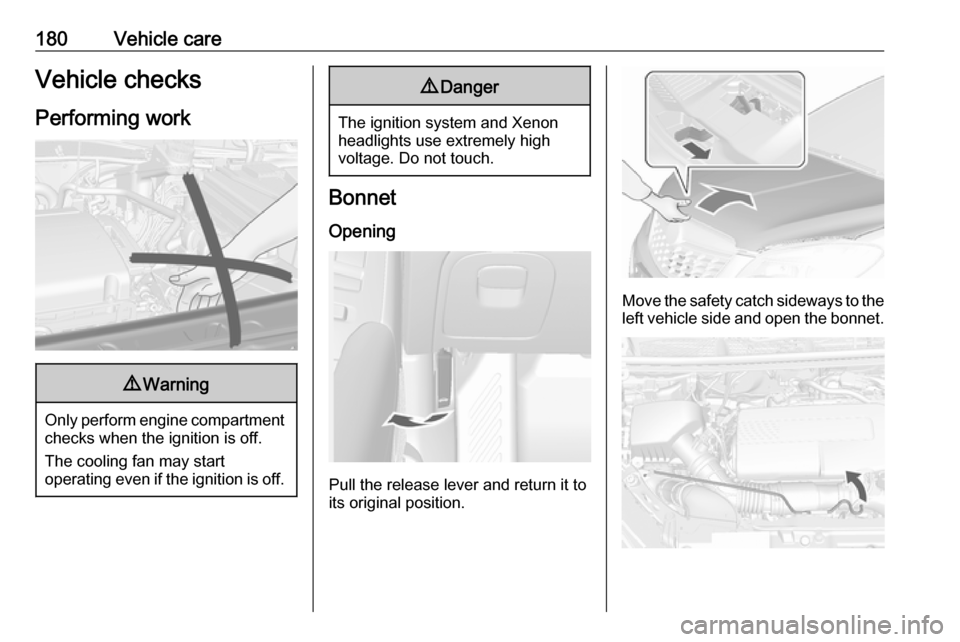lights OPEL MOKKA X 2018 Infotainment system
[x] Cancel search | Manufacturer: OPEL, Model Year: 2018, Model line: MOKKA X, Model: OPEL MOKKA X 2018Pages: 251, PDF Size: 6.61 MB
Page 180 of 251

178Vehicle careVehicle careGeneral Information...................178
Accessories and vehicle modifications .......................... 178
Vehicle storage ........................179
End-of-life vehicle recovery .....179
Vehicle checks ........................... 180
Performing work ......................180
Bonnet ..................................... 180
Engine oil ................................. 181
Engine coolant ......................... 182
Power steering fluid .................182
Washer fluid ............................ 183
Brakes ..................................... 183
Brake fluid ............................... 183
Vehicle battery ......................... 184
Diesel fuel system bleeding .....185
Wiper blade replacement ........185
Bulb replacement .......................186
Halogen headlights ..................187
Fog lights ................................. 188
Tail lights ................................. 189
Number plate light ...................190
Electrical system ........................191
Fuses ....................................... 191
Engine compartment fuse box . 191Instrument panel fuse box .......193
Load compartment fuse box ....195
Vehicle tools .............................. 196
Tools ........................................ 196
Wheels and tyres .......................197
Winter tyres ............................. 197
Tyre designations ....................197
Tyre pressure .......................... 198
Tyre pressure monitoring system .................................... 199
Tread depth ............................. 202
Changing tyre and wheel size . 203
Wheel covers ........................... 203
Tyre chains .............................. 204
Tyre repair kit .......................... 204
Wheel changing .......................207
Spare wheel ............................ 209
Jump starting ............................. 211
Towing ....................................... 213
Towing the vehicle ...................213
Towing another vehicle ...........214
Appearance care .......................215
Exterior care ............................ 215
Interior care ............................. 217General Information
Accessories and vehicle modifications
We recommend the use of genuine
parts and accessories and factory
approved parts specific for your
vehicle type. We cannot assess or
guarantee reliability of other products
- even if they have a regulatory or
otherwise granted approval.
Any modification, conversion or other
changes made to standard vehicle
specifications (including, without
limitation, software modifications,
modifications of the electronic control units) may invalidate the warrantyoffered by Opel. Furthermore, such
changes may affect driver assistance
systems, fuel consumption, CO 2
emissions and other emissions of the
vehicle. They may also invalidate the
vehicle operating permit.
Page 182 of 251

180Vehicle careVehicle checks
Performing work9 Warning
Only perform engine compartment
checks when the ignition is off.
The cooling fan may start
operating even if the ignition is off.
9 Danger
The ignition system and Xenon
headlights use extremely high
voltage. Do not touch.
Bonnet
Opening
Pull the release lever and return it to
its original position.
Move the safety catch sideways to the left vehicle side and open the bonnet.
Page 189 of 251

Vehicle care187Halogen bulbs9Warning
Halogen bulbs have pressurized
gas inside and can burst if you
drop or scratch the bulb. You or others could be injured. Be sure to read and follow the instructions onthe bulb package.
LED lighting
This vehicle has several LED lights.
For replacement of any LED lighting
assembly, contact a workshop.
Halogen headlights
Baselevel headlight assembly
The base model vehicle has halogen
high beam and low beam headlights,
an LED turn and lane-change signal,
a sidelight and daytime running lights on the headlight assembly.
Passenger side shown, driver side
similar.
On the driver side remove the
windscreen washer bottle filler neck,
before changing a bulb.
1. High beam headlights
2. Low beam headlights
High beam and low beam headlights 1. Open the bonnet. Bonnet 3 1802. Remove the protective cover.
3. Turn the bulb anticlockwise and pull straight back.
4. Disconnect the wiring harnessconnector from the bulb.
Page 190 of 251

188Vehicle care5. Install the new bulb in theheadlight assembly by turning
clockwise.
6. Reconnect the wiring harness connector.
7. Install the protective cover.
For the driver side, reinstall the
windscreen washer bottle filler neck
by firmly pushing it straight into the
bottle. Ensure that the filler neck clip
engages into the underhood electrical centre retainer.
Uplevel headlight assembly
The uplevel model vehicle has LED high beam and low beam headlights,a turn and lane-change signal, a
sidelight and daytime running lights
on the headlight assembly.Fog lights
The bulbs are accessible from the
underside of the vehicle
1. Turn the respective wheel inside to get better access and remove
three torx screws on outside of
wheel house. Vehicle tools
3 196.
2. Pull and hold lining to get access to the bulb holder.
3.Pull the retaining rib outwards and
remove plug connector from the
bulb socket.
4. Turn the bulb holder anticlockwise
and remove it from the reflector.
5. Remove and replace the bulb socket with bulb and attach the
plug connector.
6. Insert the bulb socket into the reflector by turning clockwise and
engage.
7. Re-assemble the lining and fasten
the three torx screws.
Page 191 of 251

Vehicle care189Tail lights
The vehicle has halogen turn and
lane-change signals, a back-up light
and LED tail/stop lights on the tail light assembly.
Left-hand side
1. Disengage both covers at the respective outer side by inserting
a screwdriver. Remove both
covers and unscrew screws.
Remove the panel.
2. First disengage cover by inserting
a screwdriver at the recess. Then
disengage cover at the front and
upper side. Remove cover.
Right-hand side
1. Remove the storage door and the
tyre repair kit.
2. Remove the cover.
Page 192 of 251

190Vehicle care
3. Turn and lane-change signal light(1)
Back-up light (2)
4. Remove bulb holder. Remove and renew bulb.
5.Insert bulb holder into the tail light
assembly. Install tail light
assembly in body and tighten.
Close covers and engage.
6. Switch on ignition, operate and check all lights.
Number plate light
1. Prise the light out with a screwdriver.
2. Remove bulb housing downwards, taking care not to pull
on the cable.
Rotate bulb holder anticlockwise
to disengage.
3. Remove bulb from holder and renew bulb.
4. Insert bulb holder in bulb housing and rotate clockwise.
5. Insert bulb housing and secure using a screwdriver.
Page 214 of 251

212Vehicle care● Apply the parking brake,transmission in neutral,
automatic transmission in P.
● Open the positive terminal protection caps of both batteries.
Lead connection order:
1. Connect the red lead to the positive terminal of the booster
battery.
2. Connect the other end of the red lead to the positive terminal of the
discharged battery.
3. Connect the black lead to the negative terminal of the booster
battery.
4. Connect the other end of the black
lead to a vehicle grounding point,
such as the engine block or an
engine mounting bolt. Connect as far away from the discharged
battery as possible, however at
least 60 cm.
Route the leads so that they cannot
catch on rotating parts in the engine
compartment.
To start the engine: 1. Start the engine of the vehicle providing the jump.
2. After five minutes, start the other engine. Start attempts should be
made for no longer than
15 seconds at an interval of
1 minute.
3. Allow both engines to idle for approx. three minutes with the
leads connected.4. Switch on electrical consumers (e.g. headlights, heated rear
window) of the vehicle receiving
the jump start.
5. Reverse above sequence exactly when removing leads.
Page 215 of 251

Vehicle care213Towing
Towing the vehicle
Disengage cap by using a
screwdriver and remove.
The towing eye is stowed with the vehicle tools 3 196.
Screw in the towing eye as far as it will
go until it stops in a horizontal
position.
Attach a tow rope – or better still a tow
rod – to the towing eye.
The towing eye must only be used for towing and not for recovering the
vehicle.
Switch on ignition to release steering
wheel lock and to permit operation of
brake lights, horn and windscreen
wiper.
Switch the selector lever to neutral.
Release the parking brake.
Caution
Never tow a vehicle equipped with All Wheel Drive (AWD) with the
front or rear tyres on the road. If
you tow a vehicle equipped with
AWD while the front or rear tyres
are rolling on the road, the drive
system in the vehicle could be
severely damaged. When towing
vehicles equipped with AWD, all
four tyres must not be in contact
with the road.
Caution
Drive slowly. Do not drive jerkily.
Excessive tractive force can
damage the vehicle.
When the engine is not running,
considerably more force is needed to
brake and steer.
To prevent the entry of exhaust gases from the towing vehicle, switch on the
air recirculation system 3 128 and
close the windows.
Page 218 of 251

216Vehicle careThoroughly rinse and leather-off the
vehicle. Rinse leather frequently. Use
separate leathers for painted and
glass surfaces: remnants of wax on
the windows will impair vision.
Do not use hard objects to remove spots of tar. Use tar removal spray on painted surfaces.
Exterior lights
Headlight and other light covers are made of plastic. Do not use any
abrasive or caustic agents, do not use
an ice scraper, and do not clean them
dry.
Polishing and waxing
Wax the vehicle regularly (at the
latest when water no longer beads).
Otherwise, the paintwork will dry out.
Polishing is necessary only if the paint
has become dull or if solid deposits
have become attached to it.
Paintwork polish with silicone forms a
protective film, making waxing
unnecessary.
Plastic body parts must not be treated with wax or polishing agents.Windows and windscreen wiper
blades
Use a soft lint-free cloth or chamois
leather together with window cleaner and insect remover.
When cleaning the rear window from
inside, always wipe in parallel to the
heating element to prevent damage.
For mechanical removal of ice, use a
sharp-edged ice scraper. Press the
scraper firmly against the glass so
that no dirt can get under it and
scratch the glass.
Clean smearing wiper blades with a
soft cloth and window cleaner.
Remove dirt residues from smearing
wiper blades by using a soft cloth and window cleaner. Also make sure to
remove any residues such as wax,
insect residues and similar from the
window.
Ice residues, pollution and continuous
wiping on dry windows will damage or
even destroy the wiper blades.Wheels and tyres
Do not use high-pressure jet
cleaners.
Clean rims with a pH-neutral wheel
cleaner.
Rims are painted and can be treated
with the same agents as the body.
Paintwork damageRectify minor paintwork damage with
a touch-up pen before rust forms.
Have more extensive damage or rust
areas repaired by a workshop.
Underbody Some areas of the vehicle underbody
have a PVC undercoating while other
critical areas have a durable
protective wax coating.
After the underbody is washed, check
the underbody and have it waxed if
necessary.
Bitumen/rubber materials could
damage the PVC coating. Have
underbody work carried out by a
workshop.
Page 247 of 251

245Convex shape .............................. 32
Coolant and antifreeze ...............219
Cruise control ...................... 97, 153
Cupholders .................................. 60
Curtain airbag system .................. 50
D
Danger, Warnings and Cautions ...4
Daytime running lights ...............120
Declaration of conformity ............235
Delayed locking ............................ 27
Descent control system .......95, 152
Diesel fuel system bleeding .......185
Diesel particle filter ....................143
Door open .................................... 98
Doors ............................................ 29
Driver assistance systems ..........153
Driver Information Centre .............98
Driving characteristics and towing tips .............................. 174
Driving hints ................................ 135
E
Electric adjustment ......................32
Electrical system......................... 191
Electronic climate control system 129
Electronic driving programmes ..146
Electronic key system ...................22
Electronic Stability Control.......... 151
Electronic Stability Control and Traction Control system ............95Electronic Stability Control off....... 95
End-of-life vehicle recovery .......179
Engine compartment fuse box ...191
Engine coolant ........................... 182
Engine coolant temperature gauge ....................................... 88
Engine data ............................... 227
Engine exhaust .......................... 142
Engine identification ...................223
Engine oil ................... 181, 219, 224
Engine oil pressure ......................96
Entry lighting .............................. 125
ERA GLONASS .......................... 114
Event data recorders ..................242
Exit lighting ................................ 126
Exterior care .............................. 215
Exterior light ................................. 97
Exterior lighting ....................13, 116
Exterior mirrors ............................. 32
F
Fault ........................................... 146
First aid kit ................................... 74
Fixed air vents ........................... 132
Flex-Fix system ............................ 62
Fog light ....................................... 97
Fog lights ................................... 188
Folding mirrors ............................. 32
Following distance indication ......158
Forward collision alert................. 156Front airbag system .....................49
Front fog lights ........................... 123
Front seats.................................... 39
Front storage ................................ 61
Fuel............................................. 167
Fuel consumption - CO 2-
Emissions ............................... 173
Fuel for diesel engines ..............168
Fuel for liquid gas operation .......169
Fuel for petrol engines ...............167
Fuel gauge ................................... 86
Fuel selector ................................ 87
Fuses ......................................... 191
G
Gauges ......................................... 85
Gear shifting ................................. 95
General information ...................173
Glovebox ..................................... 60
Glove box lighting .......................125
H Halogen headlights ....................187
Hand brake ................................. 149
Hazard warning flashers ............122
Headlight flash ........................... 118
Headlight range adjustment ......119
Headlights when driving abroad 119
Head restraint adjustment .............8
Head restraints ............................ 38
Heated mirrors ............................. 33